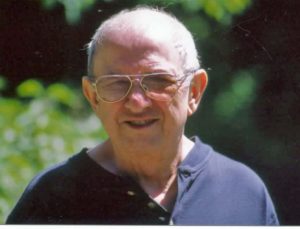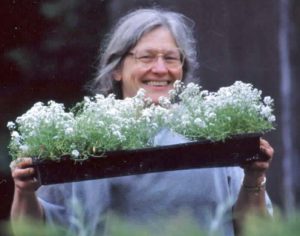 Stefano Mui Barragato
Stefano Mui Barragato
Stef was a founding teacher of Treetop Zen Center along with his wife, Margaret. Stef died in September 2010 following a five-year battle with pulmonary fibrosis. His simple, unadorned style of teaching lives at Treetop to this day.
Stef became a Zen priest in 1983 and received dharma transmission in 1996 from Bernie Glassman at Greyston Seminary in New York. He was interested in teaching a Zen that anyone could do and understand, reaching ordinary people and using everyday down-to-earth language. He called this style of practice “the little way of Zen” in honor of St. Thérèse of Lisieux, one of his role models. He was the author of the book Zen Light: Uncommon Commentaries on the Denkoroku.
Stef was born in Brooklyn, New York. One of his greatest memories was of his first baseball game. He had been playing in the streets with his friends when the cops came, put all the kids in a van, and drove them to Yankee Stadium, where Stef watched Joe DiMaggio hit one home run after another. That event turned him into a lifelong Yankee fan.
On his 18th birthday, during the Korean War, Stef registered for the draft as a conscientious objector. Unfortunately his draft board didn’t agree with him. He was ultimately sentenced to a year and a day at the Federal Correctional Institution at Danbury, Connecticut, for resisting the draft. This experience sensitized him to the plight of people trapped in the prison system, an issue that remained close to his heart for the rest of his life.
After prison, Stef went to Paraguay, where he lived for a decade in a pacifist Christian intentional community known as the Religious Society of Brothers, or the Bruderhof.
After returning to the States, Stef became a Quaker for the next 20 years. During this time, he worked as a fundraiser for the American Friends Service Committee and then for the University of Southern California, where he was director of development for the Center of Urban Affairs. He later served as the southern regional director of development for the Sierra Club Foundation and then as the executive director of the Jung Institute of Los Angeles, where he also did extensive fundraising.
While still a Quaker in Pasadena, California, Stef met Taizan Maezumi Roshi, a Japanese Zen teacher. Stef and Maezumi became fast friends, and Maezumi particularly appreciated Stef’s fundraising skills. It was during this period that Stef met most of the people who would eventually become the first generation of prominent American Zen teachers. Later, in 1980, Stef decided to chuck it all and become a Zen monk. Maezumi asked Stef to go to New York and help his senior student, Bernie Glassman, who had just started the Zen Community of New York. So Stef and Margaret packed up and moved to New York, where they lived and practiced at Greyston for the next several years.
After the Barragatos left Greyston, Stef began going to a maximum-security prison in upstate New York to teach Zen to the inmates. After Margaret retired, she also taught at the prison. Together, they taught there for about 15 years.
Stef and Margaret moved to Maine in 2003, finally settling in Oakland after about four years in the Bangor area. The mother-in-law apartment above the garage was transformed into a zendo and is now the hub of Treetop Zen Center. Stef was blessed to see the first few years of the vibrant, growing sangha that formed there.
Toward the end of his life, Stef enjoyed collecting and eating wild mushrooms, playing bridge, and expressing himself though writing fiction and playing the Baroque flute, recorder, and jazz vibes.
One of his greatest joys of living in Maine was walking in the woods with his dogs and quietly paddling his kayak along the edge of a lake, weaving through water lilies and visiting hawks, eagles, beavers, loons, and other friends.
Listen to Stef’s dharma talks.
Read Stef’s writing.
Read Stef’s memorial.
 Margaret Ne-Eka Barragato
Margaret Ne-Eka Barragato
Margaret was a co-founder of Treetop Zen Center along with her late husband, Stef. Her gentle, compassionate teaching style lives on in her dharma heir, Peter Seishin Wohl.
Margaret was born in Minneapolis and raised in the Lutheran Church like 98% of the rest of the kids in that city at the time. The church she went to had one of the world’s finest organists and, through him, she learned of the music of J. S. Bach. She fell in love with the music of Bach and with organ music in general. Minneapolis was a great place to grow up, with lots of little lakes — 12 within the city limits — and Minnehaha Falls to visit. She and her friends used to ride their bikes to the falls, park them, and then walk along the stream to the Mississippi River. It was a magical place. She often visited Minnehaha Falls in her dreams.
Margaret went to the University of Michigan, which was a loose family tradition. Her great aunt had been one of the first women to graduate from UM, and her mother and older sister were also graduates. She spent her junior year in Berlin, which was then still a divided city, because she thought she wanted to be a professor of German literature. However, while she was in Berlin, she learned of the discovery of the genetic code by Watson and Crick. She was fascinated. So when she got back to Ann Arbor, Margaret started studying biology. After graduation, she was given a DAAD fellowship to study biology in Germany. This time she went to Munich, where she did more skiing than studying.
In 1967 she went to the University of California at Berkeley to study cell biology. At some point, Margaret realized that a research biologist was not something she wanted to be. She worked in a lab to pay her expenses, studied massage therapy, and got a master of arts degree from the Graduate Theological Union. While at GTU, she learned of the spiritual exercises of St. Ignatius. She attended a number of retreats with the Jesuits there and eventually joined the Roman Catholic Church.
In Berkeley, Margaret also attended a few workshops with Tarthang Tulku Rinpoche and sat with the group at the Nyingma Institute, which formed the roots of her involvement with Buddhism.
Then she moved to Los Angeles, where she met Stef. They were together for a year when he announced he wanted to give it all up and study Zen. Margaret said, “Fine by me,” so off they went to New York to live at Greyston Seminary.
While they were in New York, Margaret decided to become a physician’s assistant, so she went back to school yet again. She worked as a PA in New York City for five years and then in upstate New York for 10 more. Mostly her job involved caring for AIDS patients at a time when the medical community had little or nothing to offer them. She learned a tremendous amount from her patients, mainly about courage in the face of suffering.
Around that same time, Margaret became interested in Zen and began studying with Stef. In 2002, she received dharma transmission. Because she was also doing a lot of teaching in the Catholic Church, she chose not to be ordained as a Buddhist priest. After Margaret stopped teaching in the church, she requested ordination and received denkai (full priest ordination) in 2005.
After the Barragatos both retired from gainful employment, they moved to Holden, Maine. The realtor who sold them their first house here mentioned Bangor Theological Seminary. Less than a week after moving in, Margaret inquired about taking a course in Greek. She wound up completing the courses for a master of divinity degree — covering such useful things as learning how to properly baptize a baby — in order to enter the doctoral program. She received her doctorate in 2007.
Margaret taught at the seminary for a few years, including a course in Buddhist-Christian dialogue, in addition to working with Zen students at Treetop. She often remarked, “From both jobs, I receive more than I give.”
Margaret loved living in Maine. The climate reminded her of Minnesota, and she said it felt like she had come home again with all the lakes and streams and the thick mosquitos. The blackflies were a new experience for her — one she could have happily lived without — but the eagles and the osprey and the muskrats more than made up for them.
One of Margaret’s greatest joys was spending time with her Labrador retriever, Molly, and her two cats, Sadie and Ari. They were sources of much entertainment and much love. All in all, she enjoyed a rich life filled with many blessings.
Listen to Margaret’s dharma talks.
Read Margaret’s writing.
